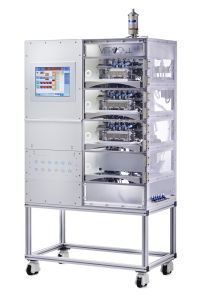Fine dusts from industry, traffic, and households are omnipresent. Still, they are difficult to capture by reliable medical measurements. KIT researchers have now developed an exposure system, by means of which biological cells are exposed to fine dust-loaded air flows in an exact and reproducible manner. Using this system, it is possible to collect data on the adverse impact of fine dusts of variable sources in a rapid and inexpensive manner and without animal experiments being needed. In cooperation with the industry partner Vitrocell, a marketable product has been developed.
“Fine dusts may be carbon black from diesel engines, sea salt on the coast, natural dusts, or intermediate products of chemical industry,” Dr. Hanns-Rudolf Paur and Sonja Mülhopt of Karlsruhe Institute of Technology explain. All dust grains smaller than 10 µm, i.e. one hundredth of a millimeter, are considered to be fine dust irrespective of their chemical composition. Dust particles smaller than 10 µm easily pass the upper respiratory tract of man. “They deposit in the pulmonary alveoli and may damage the lungs due to their chemical or physical properties.”
To study the effects in detail, lung cells and fine dust have to be brought together in a realistic environment. Ultimately, the processes taking place in the human body from the nose to the lungs have to be reproduced. For this purpose, the air containing the fine dust is heated up to body temperature by the Karlsruhe Exposure System. The air flow is provided with about 85% humidity and reduced to the air flow rate of the lungs. For a long-term measurement series, these conditions have to be maintained exactly and reproducibly. Finally, the particle flow passes lung cell cultures cultivated with nutrient medium. Depending on the type of fine dust, these cultures subsequently show symptoms of inflammation, oxidation stress, or membrane damage. In parallel, the deposited particle dose is recorded by means of a precision balance.
The new Exposure System is much closer to reality than previous methods that collected fine dust from air or exhaust gas and stirred it into the nutrient liquid. At the same time, the Exposure System works more rapidly for many applications and is cheaper than a study based on animal experiments. Thanks to its compactness, the Karlsruhe Exposure System can also be used for measurements at the place of fine dust development or pollution. ”The limitations of conventional methods were overcome by the close, interdisciplinary cooperation of biologists and process engineers at KIT,” the Head of the project, Sonja Mülhopt, says. “With the Karlsruhe Exposure System, we now have a technology that will improve the protection of the environment and mankind.”
“Research at KIT was the basis of a process with a high industry potential,” Tobias Krebs of the company Vitrocell Systems (Waldkirch) says. “Together, we now plan to commercialize this product.” The impact of fine dusts plays an important role in fundamental research as well as in many areas of application. According to the EU Directive on Chemicals REACH, chemical industry is obliged to classify its products in various hazard categories. Manufacturers of lung medicine, such as asthma sprays, are now enabled to test new substances in a close-to-reality manner. New and old biomass fuels may also be relevant fine dust sources.
Being “The Research University in the Helmholtz Association”, KIT creates and imparts knowledge for the society and the environment. It is the objective to make significant contributions to the global challenges in the fields of energy, mobility, and information. For this, about 10,000 employees cooperate in a broad range of disciplines in natural sciences, engineering sciences, economics, and the humanities and social sciences. KIT prepares its 22,800 students for responsible tasks in society, industry, and science by offering research-based study programs. Innovation efforts at KIT build a bridge between important scientific findings and their application for the benefit of society, economic prosperity, and the preservation of our natural basis of life. KIT is one of the German universities of excellence.

